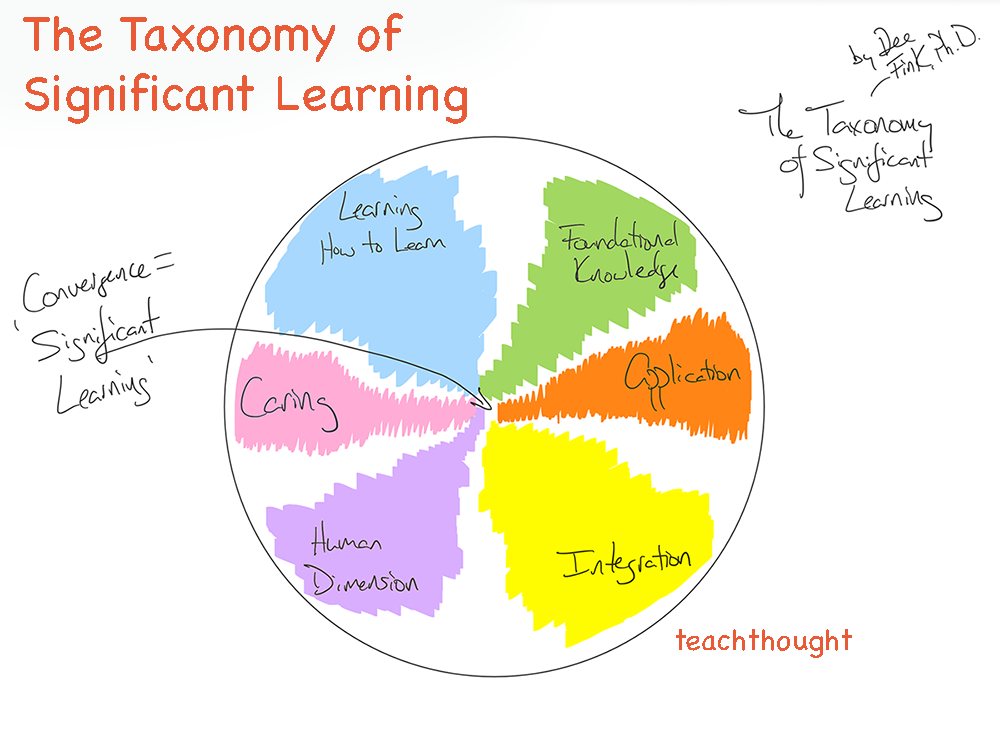
The Taxonomy Of Significant Learning
by Terry Heick
On the surface, there isn’t a lot to the Taxonomy Of Significant Learning but what’s there is useful to help frame how you design learning experiences for students.
As a preface, I should say that I have not been trained in this model, nor have I researched it with great depth. This post is meant to serve as an overview from a beginner’s perspective created for other beginners while tying in with other ‘bits and pieces’ of progressive learning. That is, we’re looking at the taxonomy from ten feet away and beginning to understand what it is, how it might help us, and how it relates to other ideas and fluences in modern education.
The idea behind the taxonomy, created by Dr. Dee Fink, seems to be describing attributes of ‘significant’ learning as opposed to ‘less significant’ learning. The former, it would seem has greater endurance and is more likely to resonate with and improve the present and future of the student while the latter is more classroom-centered and thus less ‘significant’ outside that classroom.
This isn’t an entirely new idea, having been addressed by approaches ranging from Understanding by Design’s ‘Authenticity,’ and 40/40/40 rule to books, essays, quotes, Ted Talks, and dozens of other media imploring education to focus on the work we ask students to do as much as the way we ask them to do it.
What makes this taxonomy most immediately useful is the creation of a visual framework that helps distill the concept, along with the flexibility of the model itself. The Taxonomy of Significant Learning has ‘room’ for academic skills, standards-based content, ‘whole child’ initiatives, critical thinking, and more. (Much like Project-Based Learning as a framework.)
The middle of the model, where all of these otherwise disparate ideas converge, is the ‘sweet spot’ of learning design. For example, if we design a basic math activity that seeks to build basic arithmetic skills in a 30-minute lesson in a 2nd-grade classroom, this activity would focus on the first area, ‘Foundational Knowledge.’
If we then incorporated self-knowledge by asking students to reflect on how they typically respond when asked to practice unfamiliar skills, we’re adding the ‘Human Dimension’ into the lesson, making it—according to this model—more ‘significant.’
Parsing Student-Centered Learning
Embedded in the design of the model is also the idea of student-centered teaching, mainly because it asks us to consider the student in every almost dimension as we plan a lesson. From Foundational Knowledge (to determine what is and is not Foundational Knowledge) to Application (which, ideally, should be different for most students) to Integration (which requires us to know what else they’re studying), to the Human Dimension (which is more overtly ‘student-centered), to Caring and Learning How To Learn, the Taxonomy of Significant Learning is not curriculum-centered or institutionally-centered, but more or less, student-centered.
And at TeachThought, we like that kind of thinking very much.
Of course, not every lesson can or should be entirely designed with the model, nor is it practical to personalize everything, every day. That’s a larger conversation, but for now, the model is a useful tool for your teacher toolkit as you think about personalizing the projects, activities, lessons, and units you plan for your students.
Below, I created some very basic examples of learning objectives based on the Taxonomy of Significant Learning just to give you an idea of what they might look like. What may have been more useful is to help clarify how to create learning experiences that have several of these dimensions at once (as I alluded to earlier), but I’ll leave that for another article.\
What Is The Taxonomy Of Significant Learning?
1. Foundational Knowledge
Idea: To establish a working knowledge of the language, ideas, and skills sufficient to begin using them in pursuit of additional knowledge
Sample Learning Objective: Students will establish basic fluency in a foreign language
2. Application Skills
The idea: To use what is being or has been learned
Sample Learning Objective: Students will use basic coding html skills to create a simple webpage
2. Integration
The idea: Understanding and leveraging the relationships between knowledge categories (e.g., ‘content areas’)
Sample Learning Objectives: Students will use historical knowledge to create an original piece of art for a specific audience and purpose
4. Human Dimension
The idea: Learning about the relationship between people and information (e.g., knowledge serving people versus people serving knowledge)
Sample Learning Objective: Students will use metacognitive sentence stems to identify their tendencies during the pre-writing stage of the writing process.
5. Caring
The idea: Nurturing personal perspectives and affections to contextualize and improve learning
Sample Learning Objective: Students will brainstorm possible project-based learning ideas personal to them based on their own personal life and affections
6. Learning How to Learn
The idea: To establish and improve fluency with learning as a process, cause, and human outcome
Sample Learning Objectives: Students will use a self-directed learning model to create their own learning objective
The Taxonomy Of Significant Learning
